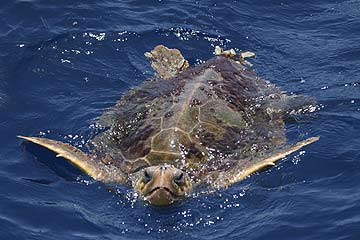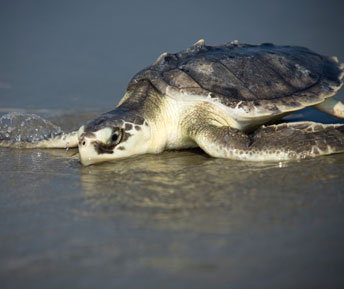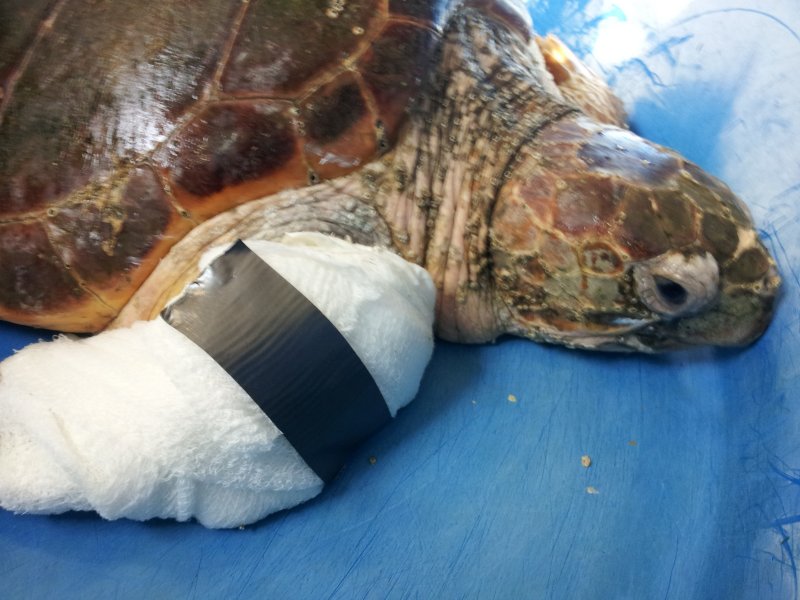damaged right front flipper
damaged carapace
I was recently invited to NCSU school of Veterinary Medicine to perform surgery on a Loggerhead sea turtle rescued off the coast of North Carolina. The sea turtle had a crushing injury to her carapace and a severely lacerated right front flipper. Her carapace or shell injury was the likely result of a boat collision. Her flipper laceration was secondary to becoming entangled in a crab pot line. The turtle’s name is Nichols and she was rescued by the Karen Beasley SeaTurtle Rescue and Rehabilitation Center.
The Karen Beasley Sea Turtle Rescueand Rehabilitation Center (KBSTRRC) is a nonprofit organization staffed by volunteers lead by Jean Beasley, in Topsail Beach, NC. Their mission is to successfully rehabilitate and release injured or sick sea turtles from the wild. Since 1996, 152 sea turtles have undergone successful rehabilitation at the center and have been released. Currently, the Karen Beasley Sea Turtle Rescue and Rehabilitation Center has the capability to treat and care for ~15-20 injured or sick sea turtles at one time. They are currently transitioning into a new facility where they can house and treat many more injured turtles. The facility is now under construction.
The most common sea turtle species found off the coast of NC include: Loggerhead (Carettacaretta), Green (Chelonia mydas), and Kemp’s Ridley (Lepidochelys kempi).
Kemp's Ridley
The Kemp’s Ridley is considered the world’s most endangered sea turtle, and has been listed as an endangered species since 1970. An adult Kemp’s Ridley measures 24 to 28 inches (62-70 cm) in carapace length and weighs between 77 and 100 pounds (35-45 kg). The Kemp’s Ridley is the smallest of the local N.C sea turtles.
Green
Green sea turtles are another endangered species found around the world. They nest in significant numbers on the east coast of Florida, as well as NC. The green turtle is the largest member of the Cheloniidae family. An average adult female green turtle can have a three foot carapace length, and weigh close to300 pounds. The largest green sea turtle ever found was an adult male with a carapace length over 5 feet.
Loggerhead
Loggerhead sea turtles are the most prevalent species in NC waters and they are the most common species treated at the Karen Beasley Sea Turtle Rescue and Rehabilitation Center. While all other species of sea turtles found near the U.S. coastline are listed as endangered, the loggerhead is classified as threatened. Adult loggerheads weigh up to 350 pounds when fully grown, with a carapace length of ~32 to 41 inches long (82-105cm).
Sea turtles spend the majority of their life in the ocean, and only come ashore when they are nesting or sick/injured. They are often injured by boaters, because sea turtles must surface to breathe. In NC, boating injuries seem to be most prevalent in the late spring to early fall. Female turtles migrate closer to shore to nest during this time. Boating accidents frequently result in severe carapace or plastron fractures, flipper lacerations, head trauma, etc. Turtles also frequently become entangled in fishing line, crab traps, rope and fishing nets, which can result in severe lacerations or even amputations of flippers.
Complete or partial flipper amputations were the most common forms of treatment for severe flipper lacerations in the past. If the amputee is a male sea turtle, the prognosis for losing a rear flipper is better than losing a front flipper since they hold onto females during breeding. On the contrary, females are better off losing a front flipper since the rear flippers are essential for digging nests in the sand. Female turtles can not dig a hole of appropriate depth with only one hind flipper. It has been shown that navigation and swimming is not affected by the loss of one flipper.
I have been involved in multiple surgical sea turtle procedures for KBSTRRC. Shell or carapace fractures are treated by stabilizing the shell with stainless steel plates and screws. Many times the broken shell becomes nonviable or necrotic and is debrided along with dead soft tissue. Overtime the healing new shell and soft tissue fill-in the space. Head injuries are also addressed by repairing associated soft tissue or applying bone plates to the skull. I have also repaired or salvaged severe lacerations in these turtles instead of complete or partial amputations. Primary repair of a severe flipper laceration gives the turtle the best chance of success once released in the wild to nest or breed. It is probable the same turtle could have another injury to a flipper over time.
I have reconstructed two flippers in Sea turtles in the past. I repaired a near full thickness back flipper laceration on a Loggerhead turtle (Bunswick II) who was completely rehabilitated. He was released approximately 1 year post-injury with nearly normal flipper function. A partial amputation was performed on a Kemps Ridley sea turtle (Briggy) because the end of the flipper could be preserved. However I used some of the viable skin to create a skin flap to reconstruct the remaining flipper. He was rehabilitated and released nearly a year later as well. Both cases were reported in the Journal of Zoo and Wildlife Medicine in 2009. The journal discusses each case in more detail, and is listed below.
I recently repaired Nichols flipper laceration in the same manner as Brunswick II. His bones were pulled together with suture (Toggled) and then the soft tissue was repaired. My counterpart in surgery Dr. Roe debrided and cleaned his Carapace injury. The carapace wound will be allowed to heal by second intention (allow his body to repair the wound over time). Last report is he has been doing well. However, some of the sutures have loosened which toggled his bones back together. I suspect it will continue to stabilize with scar tissue over time, and hopefully he will be released as well.
Simon and Grafinger viewing CT results
CT of flipper
Nichols after surgery
You can check on status of Nichols if you visit the www.seaturtlehospital.org website; just click on Nichols. You can also review past histories of the other turtles rehabilitated (Briggy, Brunswick II, etc.). Consider adopting a turtle and contributing to the sea turtle hospital by volunteering or making a financial donation. They do wonderful work and continue to give each and every sea turtle a fighting chance.
-Mike Grafinger, DVM, DACVS













